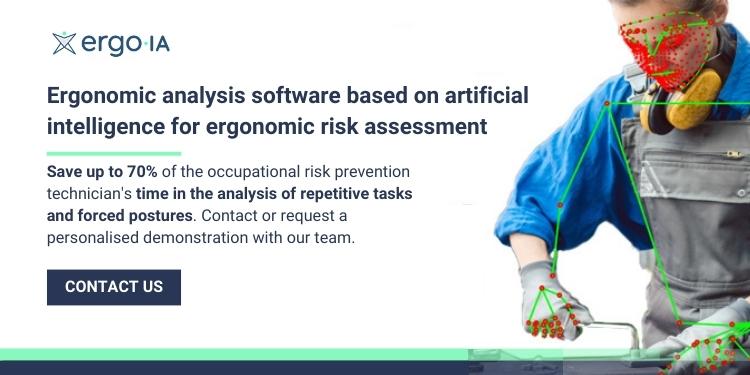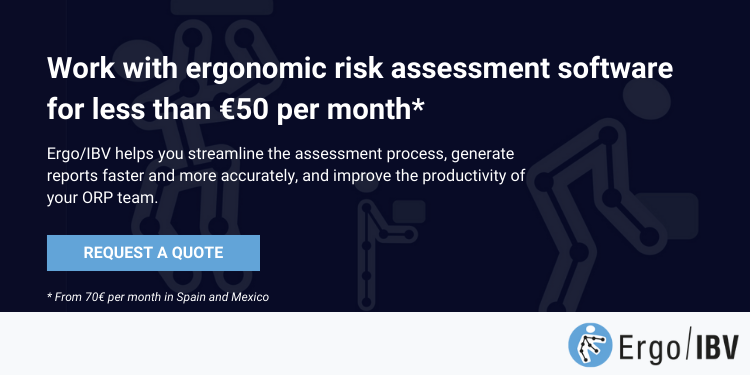Repetitive movements at work: risks, injuries and prevention
Repetitive movements are a global occupational health and safety problem that affects large numbers of workers around the world. It is in fact one of the main causes of musculoskeletal injuries and the main cause of disability with more than 1,710 million people affected worldwide, according to the WHO.
If we zoom in on Spain, the figures are not optimistic either: 82.8% of the occupational diseases reported in 2022 were musculoskeletal disorders (MSDs) caused by awkward postures or repetitive movements at work, according to the annual report of the Confederal Secretariat of Occupational Health (CCOO).
For all these reasons, identifying and preventing the risks associated with these types of movements is essential if we are to guarantee health and safety in the workplace.
In this article, we will examine the ergonomic risks and injuries associated with repetitive movements, as well as the preventive measures that can be implemented to prevent these injuries.
Repetitive movements at work: What are they?
Repetitive movements at work are understood to be all those repetitive actions that involve exertion or rapid movement of small muscle groups, usually accompanied by awkward postures and lack of adequate muscle recovery.
These activities are frequent in many sectors, such as industry, agriculture, commerce or construction, where manual tasks such as assembly line work, packaging, assembling or finishing small parts are common. However, they are also increasingly common in traditionally safe jobs where the computer has become a commonly used tool.
In fact, 57% of workers in the European Union say that they regularly perform repetitive movements with their hands or arms at work, and 42% regret not having the freedom to decide when to take a break, according to data from the European Agency for Safety and Health at Work itself.
What are the effects of repetitive movements at work?
The effects of repetitive movements at work can be significant. The most visible consequence is Repetitive Motion Injury (RMI), a type of condition that typically affects the neck, shoulders, elbows, wrists and knees, producing inflammation and pain in these areas.
Specifically, RMIs occur when there is a combination of the following work conditions:
- Repetitive movements.
- Maintaining awkward postures.
- Exerting force.
- Lack of muscular rest.
In addition, additional aggravating factors such as the use of vibrating tools, contact with cold surfaces, or localized pressure in certain areas increase the risk of developing these conditions.
Repetitive movement risk factors
According to the European Agency for Safety and Health at Work, 3 of the 4 most frequent occupational health and safety risk factors are related to RMIs.
These usually manifest themselves in the form of pain, swelling, tingling or loss of strength. The most frequent include the following:
- Tendonitis: An inflammation of the tendons caused by excessive or repetitive use of a muscle. It can affect any tendon in the body, but is especially common in the shoulder, elbow and knee.
- Carpal tunnel syndrome: A condition in which the median nerve, which runs from the forearm to the hand, is compressed at the wrist.
- Tenosynovitis: This is caused by inflammation of the sheath that surrounds a tendon, resulting in friction of the tendon. The wrist, elbow and ankle are the main areas at risk.
- Bursitis: An inflammation of the bursa, a small fluid-filled sac that acts as a shock absorber between bones, muscles and tendons. It is especially common in the shoulder, knee and hip.
Importance of preventing repetitive movement-related injuries
The occurrence of RMIs has numerous negative consequences for workers, companies and society as a whole. Focusing on their prevention should therefore be a central issue for everyone.
The most visible consequence is absenteeism and its associated costs. According to a report by ADECCO, the costs derived from absenteeism in Spain amounted to 37 billion euros in 2021, which represents 3.1% of GDP.
It is important to bear in mind that these sick leaves represent a high cost for companies, especially in terms of hours not worked, the cost of training replacement workers and lost reduction productivity. Companies are not the only ones to be affected however: public funds are also greatly affected by the cost of benefits or medical expenses, among many other variables.
Preventive measures to avoid repetitive movements at work
Preventing RMIs involves addressing the risk factors that cause them. There are several lines of action: reducing repetitive movements, improving working postures, minimizing the efforts made, etc. Below, we explore a number of preventive measures related to these lines of action.
Ergonomic design of the workplace
This is a worker-centered approach that seeks to minimize the risks of injury and MSDs, improve productivity and reduce fatigue by creating safe, healthy and efficient working environments.
Among others, it includes the proper selection of furniture and equipment, the optimal arrangement of elements in the workspace, the implementation of safety and injury prevention measures, and the adaptation of processes and tasks to the capabilities and needs of workers.
Task rotation
Extending or alternating tasks to reduce repetitive movements and organizing work in such a way that workers rotate between jobs is one of the most effective measures to end RMIs. This ensures that the same muscle groups are not always overloaded.
Training in good work techniques
Workers should be trained in good ergonomic practices so that they are able to perform their tasks as safely as possible and minimize the risk of injury. In addition, it will be necessary to provide workers with training on the tools they use to ensure that they use them correctly.
Regular breaks and stretching
To avoid the harmful effects of repetitive movements, it is essential to encourage rest and recovery breaks and stretching exercises and to distribute them appropriately throughout the working day. It is also advisable to adapt the pace of work to the individual’s capabilities and, as far as possible, allow him or her to manage their own breaks.
Ergonomic risk factor identification software
Throughout this process, occupational risk assessment software such as Ergo/IBV can be of great help in speeding up the assessment process, determining the risk level of each task and generating reports quickly. All of this translates into process standardization, improved productivity and reduced occupational risks.
Advantages of Ergo/IBV for the prevention of repetitive movements at work
The Ergo/IBV software greatly facilitates the assessment of risks derived from repetitive movements by making it possible to analyze repetitive upper body tasks with defined work cycles taking into account the percentage of time the worker is exposed to each task and posture.
In addition, it takes into account key factors for a correct MSD assessment that are often neglected in other models.
Specifically, in the hand-wrist area, it considers relevant aspects such as flexion/extension, radial/ulnar deviation, wrist pronation/supination, repetitive movements and the duration of the activity.
In the neck and shoulder area, key variables such as the effect of arm elevation, neck flexion, lateral tilt and neck roll, repetitive arm movements and the duration of the activity are included in the equation.
This software has 2 modules specifically designed for this purpose:
- Repetitive tasks module: allows the analysis of tasks involving repetitive movements of the upper limbs, calculating the level of risk of MSI in the neck-shoulder and hand-wrist areas.
- OCRA multitasking module: allows the analysis of repetitive upper limb tasks with clearly defined work cycles, considering exposure times in minutes and describing the sequence of tasks and breaks taken by the worker during the working day.
As you can see, repetitive movements at work are more present than we think and can only be tackled through a clear understanding of the risks and preventive measures by both companies and workers.
To this end, effective occupational risk assessment software such as Ergo/IBV can be key, as it facilitates the process and allows the most appropriate preventive and corrective measures to be taken. Would you like to try Ergo/IBV ergonomics software? Request a full 15-day demo by following this link.


